Guide to Everest Base Camp and Gokyo Lakes Trek
Page Contents
Toggle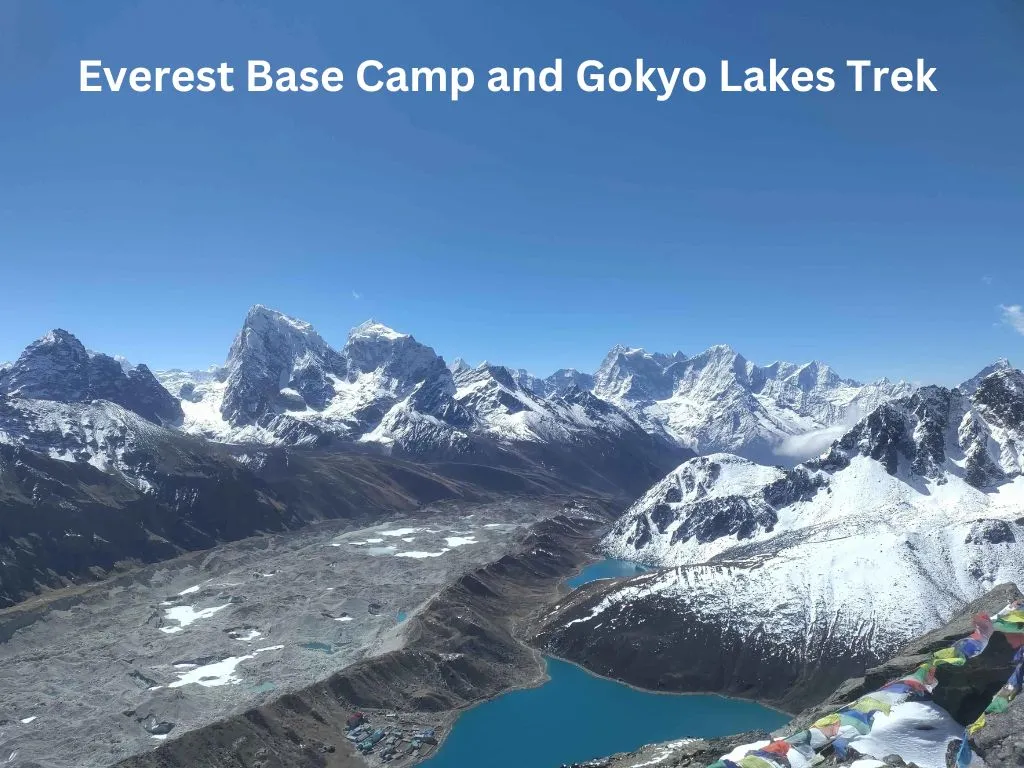
Trek Facts
- Difficulty: Strenous
- Max Elevation: 5,555 m
- Best Time: Mar, Apr, May, Sept, Oct & Nov
- Transportation: Flight & By Road (Private / Public Vehicle)
- Trek Duration: 16 Days
- Accommodation: Hotel / Teahouse
- Per Day Walking: 5 - 6 Hours
- Trek start and End Point: Kathmandu
Everest Base Camp and Gokyo Lakes Trek Overview
Everest Base Camp and Gokyo Lakes Trek is one of the most scenic and popular trekking destinations in the Khumbu region of Nepal. Since this particular trek does not follow the usual route to the Everest Base Camp Trek, i.e., from Namche Bazar to Everest Base Camp, it is quiet and less crowded, allowing you to enjoy nature unhindered.
EBC and Gokyo Lake Trek is an adventurous, amusing, and unforgettable journey to the most iconic and popular treks in Nepal. The trek starts from the usual destination of Lukla to Namche Bazaar, but rather than following the classic route of EBC Trek and going to Tengboche, you will head towards the diverse routes consisting of two small towns Dole and Mochhermo, which lead you towards the Gokyo Lake and Gokyo Ri.
Walking through the Namche Bazar route to Dole, you can witness spectacular views of different mountains like Mt. Ama Dablam, and Mt. Khumbi La. You will pass through pine and rhododendron trees.
After reaching Dole, you will follow the trail of Machhermo. The trail is quite gentle, peaceful, and easy to walk. You will see the spectacular views of Mt. Cho Oyu which is the sixth-tallest mountain in the world. The stunning view of Mt. Cho Oyu will take your tiredness away from your whole day's walk.
Before reaching The trail from Machhermo to Gokyo Lake will take you through beautiful pine and rhododendron trees.
Gokyo Lake is one of the major attractions of the trek. There are 6 major lakes in Gokyo located at 4700 m to 5000 m altitude. Gokyo Lakes is the highest freshwater lake in the world. Another major attraction in the trek is the Gokyo Ri viewpoint.
According to local guides and teahouse owners, Gokyo Ri is the best point to witness Mount Everest and other giant mountains. You will witness four 8000 m peaks including Mount Everest (8848.86 m), Makalu (8481 m), Lhotse (8516 m), Cho Oyu (8188 m ), and other mountains including Mount Amadablam (6812 m), Pumori (7161 m) from Gokyo Ri viewpoint which you don’t want to miss.
After ascending and hiking for a few days, you will reach your main destination, Everest Base Camp. To reach EBC (Everest Base Camp), you pass through Chola Pass (5420 m), Lobuche, Khumbu Glacier, and Gorakshep.
Cho La Pass is one of the highest mountain passes and an adventurous trek route. You can walk through the icy glacier on this challenging trekking path to Everest Base Camp, which requires both physical and mental endurance. You have to be physically demanding to cross through the pass. When we get to Gorakshep village, we will have to hike for a few hours to reach EBC.
The trek is magnificent with a remote trekking trail and challenging high-altitude trek in the beautiful Everest region of the Himalayas. The views of the Everest region is truly mesmerizing and the trek offers you the best adventure in the Himalayan region of Nepal.
Key Highlights of the Trek
- Witness spectacular views of Mt. Everest (8848m) from Gokyo Ri and Everest Base Camp.
- The cultural and tourism privileges of Namche Bazar.
- The adventurous and one of the most dangerous flights to Lukla.
- Impressive and captivating view of Khumbu Icefall.
- Prayer wheels, Mani stones, and high suspension bridges.
- Stunning mountain views of over 8000 meters like Mt. Everest, Makalu, Cho Oyu, and Lhotse.
- Stunning sightseeing of the famous Himalayas like Mount Amadablam (6812 m), Cholatse (6440 m), and Pumori (7161 m) throughout the journey.
- Walk Through UNESON World Heritage Site - Sagarmatha National Park.
- You get to explore through the hidden valley of Gokyo and Gokyo Lakes.
Trek Route Overview
Day1: Drive southeast from Kathmandu to the small city of Manthali
Day 2: Take a short adventurous flight from Manthali Airport to Lukla. Trek to Phakding (2,610 m) and enjoy the rivers and green forests.
Day 3: Trek from Phakding to Namche Bazaar (3,440 m), the largest town in the Khumbu region.
Day 4: Today is an acclimatization day in Namche Bazaar. So explore Namche Bazaar and take a day hike to the beautiful village of Khumjung or Hotel Everest View for coffee and beautiful views.
Day 5: Trek from Namche Bazaar up to Dole (4200 m / 13779 ft). From here, you will get separated from the classic Everest Base Camp Trek
Day 6: Trek from Dole to Machhermo (4,470m / 14,450ft).
Day 7: Trek from Machhermo to the tiny village of Gokyo (4,790m / 15,584ft) and witness pristine Gokyo lakes and beautiful views.
Day 8: Today is an acclimatization Day at Gokyo. Hike to Gokyo Ri Viewpoint (5357 m / 17,575 ft) and see 360-degree mountain views from the top.
Day 9: Trek from Gokyo to the small village of Thangnak (4,700m / 15,400ft).
Day 10: Trek from Thangnak to Dzongla (4,855m / 15,930ft). You will cross Cho La Pass (5420m / 17,783ft), the highest point on the trek.
Day 11: Trek from Dzongla to Lobuche (4,910 m / 16,175 ft).
Day 12: Trek from Lobuche to the small village settlement Gorakshep (5,185 m / 17,010 ft) and hike to Everest Base Camp (5,364 m / 17,598 ft) and return to Gorakshep.
Day 13: Hike up to Kala Patthar early in the morning (5,555m / 18,208ft) for the best Everest View. Then trek to Pheriche (4,250m / 13,945ft).
Day 14: Trek from Pheriche (4,250 m / 13,945 ft) to Namche Bazaar (3,440 m / 11,285 ft).
Day 15: Descend to Lukla
Day 16: Fly to Manthali and drive back to Kathmandu
Everest Base Camp Via Gokyo Lakes Itinerary
Day 1: Kathmandu to Manthali (Ramechhap District)
Drive: Kathmandu to Manthali (5 hr)
Overnight: Manthali
Accommodation: Lodge
It’s very hard to book a flight directly from Kathmandu in peak season due to the high tourist flow. So to avoid air traffic most of the flights are routed from Manthali to Lukla.
Your journey to Everest Base Camp and Gokyo Lakes starts with a 6-hour drive from Kathmandu to Manthali. Manthali lies in the Northeast of Kathmandu valley.
The road trip is quite good with awesome scenic views of green hills. You stay overnight in Manthali and get ready for the next day's flight to Lukla.
Day 2: Fly to Lukla (20 Minutes Flight) and Trek to Phakding (2610 m)
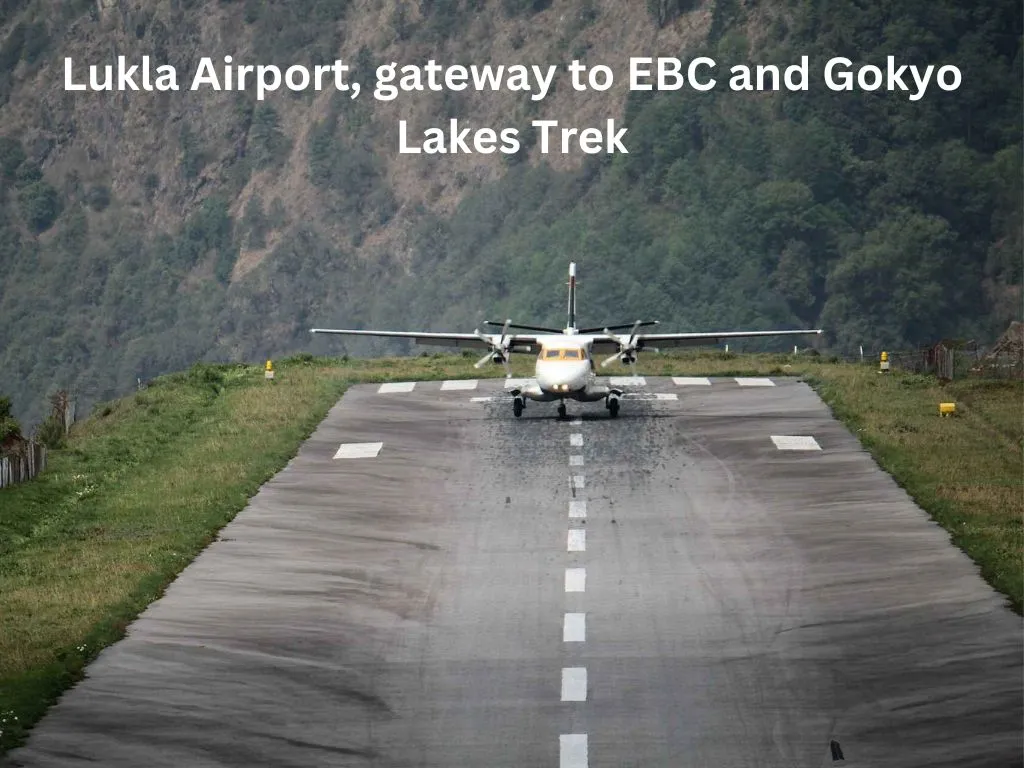
Flight: Manthali Airport to Lukla Airport (20 min)
Trek starting point: Lukla (2,860 m / 9,383 ft)
Trek distance: 8.2 km / 5.1 mi
Trek duration: 3-4 hours
Overnight: Phakding (2,610 m / 8,562 ft)
Accommodation: Teahouse (Lodge)
Today starts with a 20-minute flight from Manthali to Lukla. Lukla Airport is one of the world’s most dangerous airports in the world. The short runway, unpredictable weather, and the fog during the flights make it extremely dangerous. The moment you land, you are off on the trail!
The path from Lukla to Phakding will take you through Chaurikharka Village, down to Dudhkoshi, and then to Phakding, the destination for the day.
Day 3: Phakding (2610 m) to Namche Bazaar (3440 m / 11,286 ft)
Starting point: Phakding (2,610 m / 8,562 ft)
Trek distance: 9.4 km / 5.6 mi
Duration: 5-6 hours
Highlight: Crossing the Hillary Suspension Bridge
Overnight: Namche Bazaar (3,440 m / 11,286 ft)
Accommodation: Teahouse.
The trek route from Phakding to Namche Bazar is beautiful and gets a little tough. You will walk along the banks of the Dudh Koshi River and cross the famous Hillary Suspension Bridge.
As you move ahead, you will reach Sagarmatha National Park, where you register your permits and climb up through the dense forest from where you can see the first view of the mighty Mt. Everest if the weather is clear enough. You will continue trekking until you reach Namche Bazaar.
Day 4: Acclimatization at Namche Bazaar

Highlight: hike to Hotel Everest View and Khumjung Village.
Hotel Everest View Elevation: 3,880 m / 2,730 ft
Khumjung Village Elevation: 3790 m
Overnight: Namche Bazaar (3,440 m / 11,286 ft)
Accommodation: Same teahouse as the night before.
Namche Bazar is beautifully located and a major economic hub. This will be your first extra day entirely allocated for acclimatization only. Namche Bazaar has numerous cafes, restaurants, and hotels connected with wifi, souvenirs, and gear shops.
You can visit Hotel Everest View (3880 m) where you can witness a 360-degree view of the awe-inspiring peaks including Mt. Everest and Ama Dablam.
You can visit Khumjung Village (3790 m). It is a small village with a Sherpa culture, an old monastery, and a stunning mountain view.
The hike to Hotel Everest View and Khumjung Village is perfect for acclimatization. This is what you call the "hike high, sleep low" strategy, and it is great in helping your body to acclimatize better to the high altitude.
Day 5: Trek from Namche Bazaar (3440 m / 11,286 ft) to Dole (4200 m)
Starting point: Namche Bazar (3440 m / 11,286 ft)
Trek distance: 11 km / 6.83 mi
Duration: 5-6 hours
Overnight: Dole (4200 m / 11,286 ft)
Accommodation: Teahouse.
After spending your day at Namche Bazaar for acclimatization, you will trek towards Dole. This is where your path separates from the classic EBC Trek.
The path to Dole has many ups and downs. After about two hours of trekking, we will reach Mong La Pass (3957m / 12982ft).
From here, we can get amazing views of Mt. Ama Dablam (6,812m / 22,349ft) and Mt. Khumbila (5,761m / 18,901ft). As we move forward, our trail takes us downhill through forests full of pine and rhododendrons and then at Phortse Tenga, a riverside village. However, we will move ahead until we reach our destination for the day at Dole.
Day 6: Dole (4200 m / 11,286 ft) to Machhermo (4,470m / 14,450ft)
Starting point: Dole (4200 m / 11,286 ft)
Trek distance: 7 km / 4.8 mi
Duration: 5-6 hours
Overnight: Machhermo (4,470m / 14,450ft)
Accommodation: Teahouse.
You leave Dole and climb higher, which takes you to beautiful meadows and you will see several shrines and prayer flags.
The path ascends above the Dudh Koshi River. You can witness the stunning Mt. Cho Oyu (8188 m / 26,863 ft), the fifth tallest mountain in the world.
After walking up the hill, you will arrive at the small settlement of Macchermo. Aside from the teahouses and the villager's homes, the village has a health post with medical personnel.
Day 7: Machhermo (4,470m / 14,450ft) to Gokyo (4,790m / 15,584ft)
Starting point: Machhermo (4,470m / 14,450ft)
Trek distance: 5.7 km / 3.5 mi
Duration: 4-5 hours
Overnight: Gokyo (4,790m / 15,584ft)
Accommodation: Teahouse.
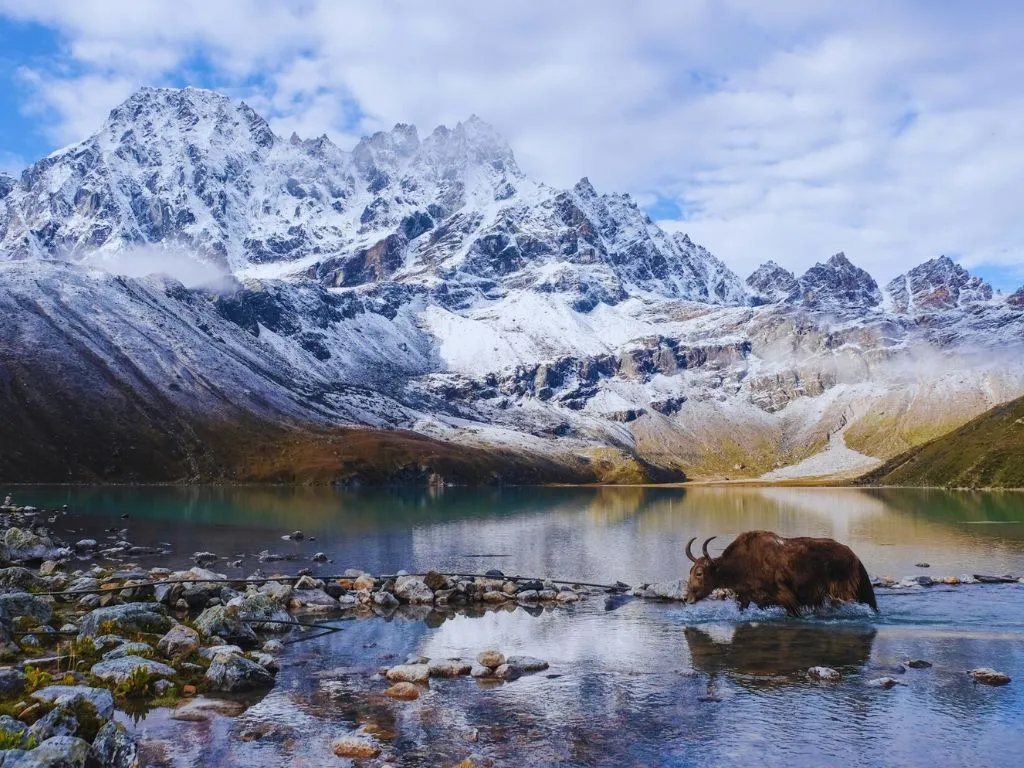
Today you will finally witness the Gokyo Lakes. After an hour's trek, you will be crossing Phanga where you can witness the memorials of people who lost their lives during the landslides. You will see views of the Gokyo lakes throughout this trek route to Gokyo valley.
As you hike up, you will reach the outlet of the first Gokyo Lake, the smallest among the five major Gokyo lakes. The Gokyo village is a short walk from the third Gokyo Lake and is one of the highest settlements in Nepal. In the uphill, you will witness the famous Gokyo Ri viewpoint.
Day 8: Acclimatization Day at Gokyo. Hike to Gokyo Ri Viewpoint (5357 m / 17,575 ft)
Starting point: Machhermo (4,470m / 14,450ft)
Trek distance: 1.5 km / 3.5 miles
Duration: 1.5 - 2 hours
Overnight: Gokyo (4,790m / 15,584ft)
Accommodation: Teahouse.

On this day, you will explore Gokyo Valley and hike up to the famous and major attraction of the trek, Gokyo Ri. Gokyo Ri offers a panoramic view of four of the six highest mountains in the world, including Mt.Everest (8,848m), Lhotse (8,516m), Makalu (8,485m), and Cho Oyu (8,188m).
Day 9: Gokyo (4,790m / 15,584ft) to Thangnak (4,700m / 15,400ft)
Starting point: Gokyo (4,790m / 15,584ft)
Trek distance: 3.7 km / 2.3 miles
Duration: 5 - 6 hours
Overnight: Thangnak (4,700m / 15,400ft)
Accommodation: Teahouse.
After your acclimatization day at Gokyo, you continue to trek to Thangnak (also known as Dragnag). Yo will pass Ngozumpa Glacier. The trail is full of ups and downs, but it is a shorter trek.
You will stay overnight at Thangnak village and prepare yourself for Cho La Pass.
Day 10: Trek from Thangnak (4,700m / 15,400ft) to Dzongla (4,855m / 15,930ft) by Cho La Pass (5420m / 17,783ft)
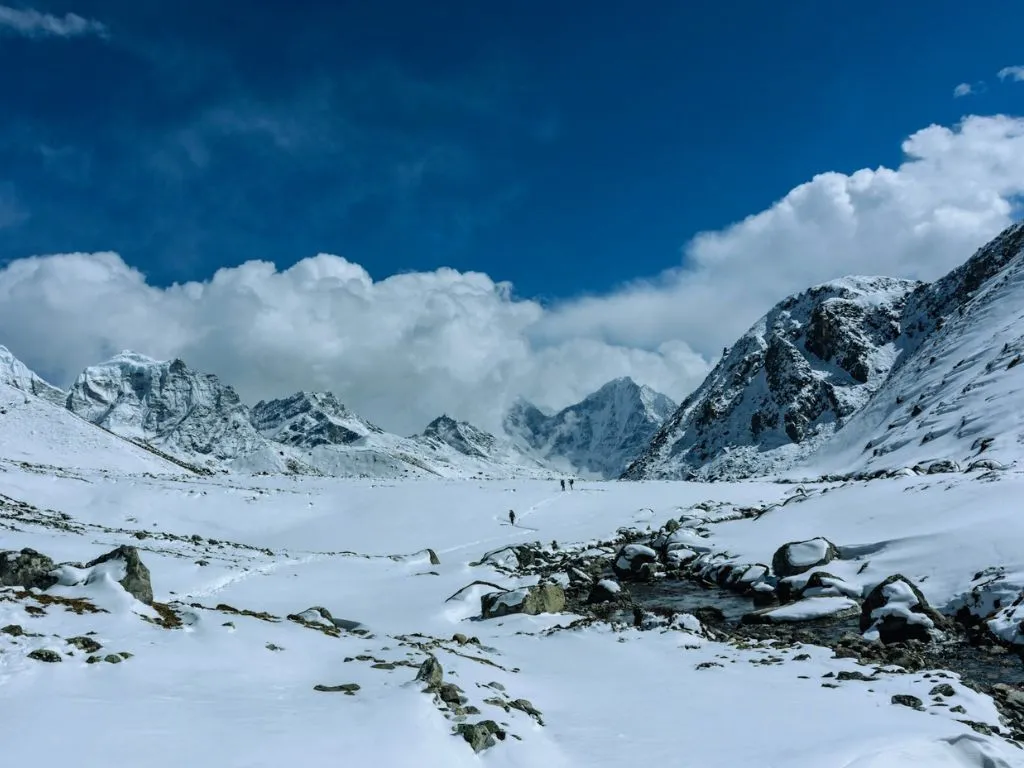
Starting point: Thangnak (4,700 m / 15,400 ft)
Trek distance: 16 km / 9.9 miles
Duration: 6 - 7 hours
Overnight: Dzongla (4,855m / 15,930ft)
Highest Altitude: 5420 m
Accommodation: Teahouse.
After spending the night at Thangnak, you will trek to Dzongla the next day. You will be hiking uphill over the rocky trails and the glacial way to the top of the Pass (5420m / 17,783ft). After a couple of hours of trek, you will reach the top of the Pass, which will reward you with a magnificent view of Mt. Cholatse (6,440m).
The trail becomes slippery as we descend. The scenes you get to enjoy from this trek are very pleasant. After some hours of downhill trek, you will reach your destination for the day - Dzongla.
Day 11: Trek from Dzongla (4,855m / 15,930ft) to Lobuche (4,910m / 16,175ft)
Starting point: Dzongla (4,855 m / 15,930 ft)
Trek distance: 8.36 km / 5.2 miles
Duration: 4 - 5 hours
Overnight: Lobuche (4,910 m / 16,175 ft)
Highest Altitude: 4910 m / 16,175 ft
Accommodation: Teahouse
You will start your day following the moraine, and descending along with Chola Lake. You will then trek through the Khumbu Glacier. Unlike your previous day, the trek to Lobuche is more pleasurable and easy.
On your way, you can see the memorial statues of the climbers, who passed away in this region. Before arriving in Lobuche, you will follow Imja Khola. After almost four hours of trekking, you will arrive at Lobuche, where you will join the classic Everest Base Camp Trek.
Day 12: Trek from Lobuche (4,930 m / 16,175 ft) to Gorakshep (5,185 m / 17,010 ft). Hike to Everest Base Camp (5,364 m / 17,598 ft) and back to Gorakshep.
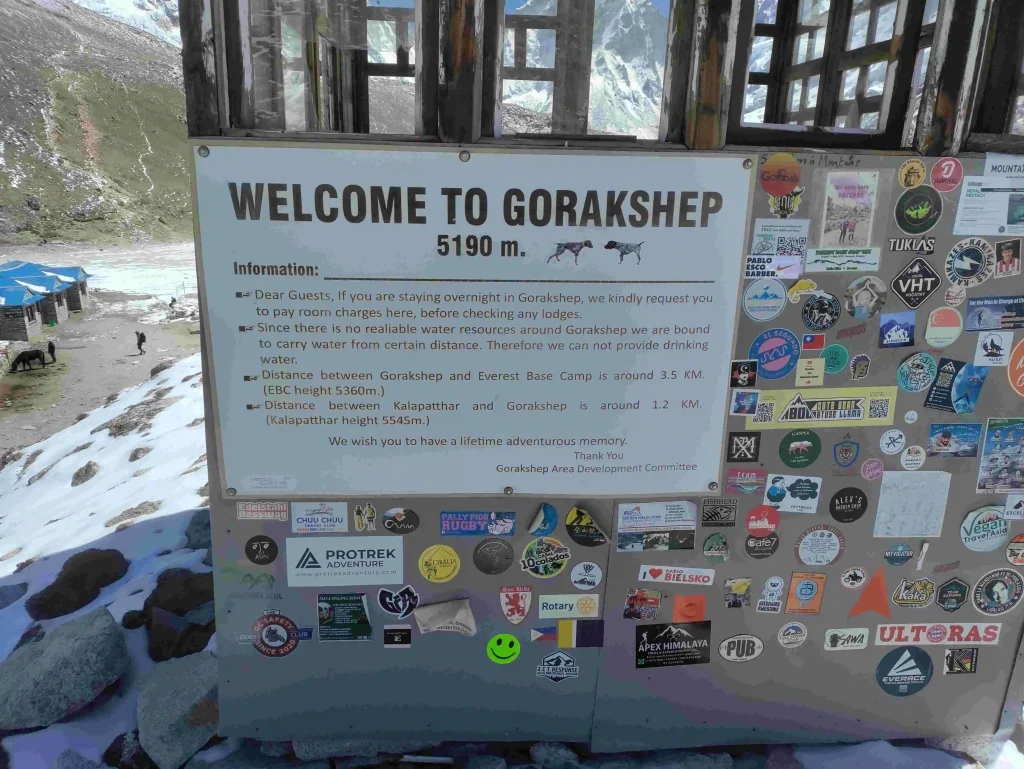
Starting point: Lobuche (4,930 m / 16,175 ft)
Trek distance: 15 km / 9.32 miles
Duration: 7 - 8 hours
Overnight: Gorakshep (5,185 m / 17,010 ft)
Highest Altitude: Everest Base Camp (5,364 m / 17,598 ft)
Accommodation: Teahouse
Finally, this is the day, you will be reaching the most awaited destination of your journey Everest Base Camp.
However, the journey will start at Lobuche and elevate as we approach Gorakshep. Once you reach Gorakshep, you will book a room, leave your belongings there, and head up to the Everest Base Camp.
Once you reach Everest Base Camp you will be amazed by the view and Mt. Everest standing right in front of you. The views from EBC are incredible and you will enjoy a 360-degree view of the mountains along with the Khumbu Glacier.
After enjoying the views from EBC, you will trek down to Gorakshep and spend the night there. If your journey is upto the Everest Base Camp, your journey
Day 13: Hike to Kala Patthar (5,555m / 18,208ft) viewpoint, trek to Gorakshep, and then to Pheriche (4,250m / 13,945ft)
Starting point: Gorakshep (5,185 m / 17,010 ft)
Trek distance: 9.6 km / 6 miles
Duration: 5 -6 hours
Overnight: Pheriche (4,250m / 13,945ft)
Highest altitude: Kala Patthar (5,555 m / 18,208 ft)
Accommodation: Teahouse
After waking up early you hike to Kala Patthar to catch the dawn breaking on Everest and the surrounding peaks. The way up to Kala Patthar can be a tough one but it is worth a hike. The sights you will be witnessing are mesmerizing from the top.
After spending time at the Kala Patthar viewpoint you will descend to Gorak Shep. Then you will head down to Pheriche.
Day 14: Pheriche (4,250 m / 13,945 ft) to Namche Bazaar (3,440 m / 11,285 ft)
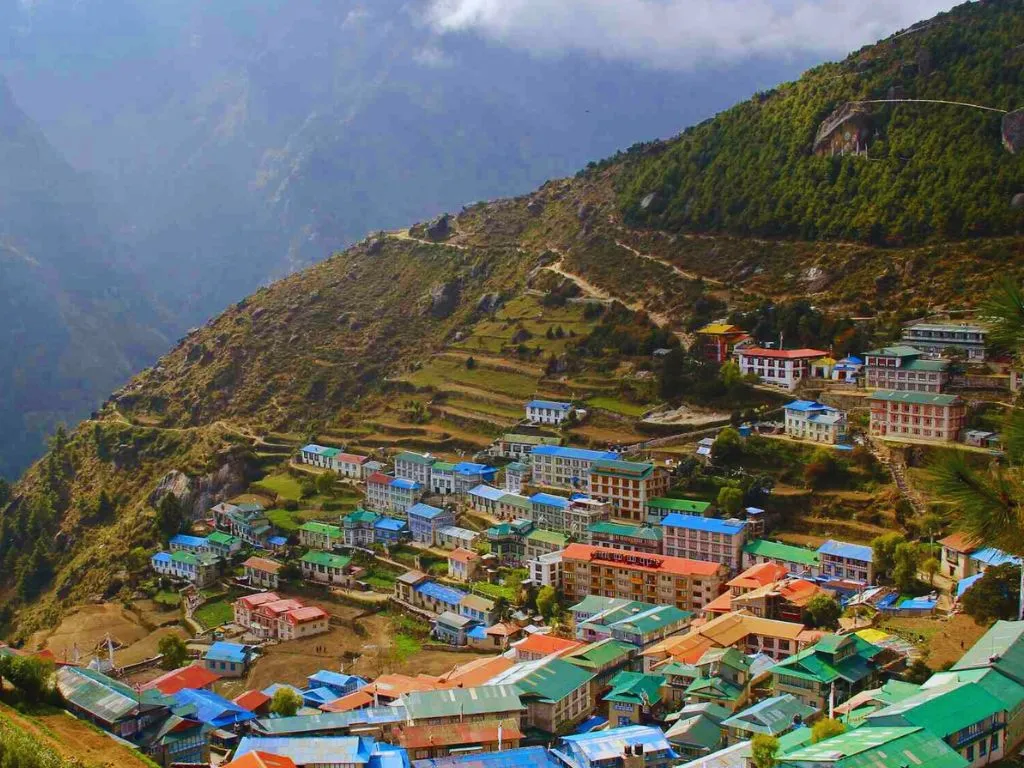
Starting point: Pheriche (4,250 m / 13,945 ft)
Trek distance: 14.3 km / 8.8 miles
Duration: 7 hours
Overnight: Namche Bazaar (3,440 m / 11,285 ft)
Highest altitude: Pheriche (4,250 m / 13,945 ft)
Accommodation: Teahouse
Today you head to Namche Bazaar. You will pass through forests and might witness wildlife like pheasants, musk deer, mountain goats, etc.
It is sad to say but this day will be the last you witness Mt. Everest. On the way, you will see numerous prayer flags and chortens.
After 7 hours of hard walking, you will finally reach Namche Bazaar.
Day 15: Namche Bazaar (3,440m / 11,285ft) to Lukla (2,850m / 9,350ft)
Starting point: Namche Bazaar (3,440 m / 11,285 ft)
Trek distance: 13.5 km / 8.3 miles
Duration: 6 - 7 hours
Overnight: Lukla (2,850m / 9,350ft)
Highest altitude: Namche Bazaar (3,440m / 11,285ft)
Accommodation: Teahouse
Today is your last day on the trekking trails. You will hike down to Lukla crossing the Hillary Suspension Bridge, and passing through several local villages.
After walking for 6 - 7 hours you will finally reach Lukla. It will most probably be your last night in the Khumbu region.
Day 16: Fly back to Manthali from Lukla (2,850m / 9,350ft) and drive back to Kathmandu
Flight: Lukla to Manthali
Flight duration: 20 minutes
Useful Information on Everest Base Camp and Gokyo TrekKing
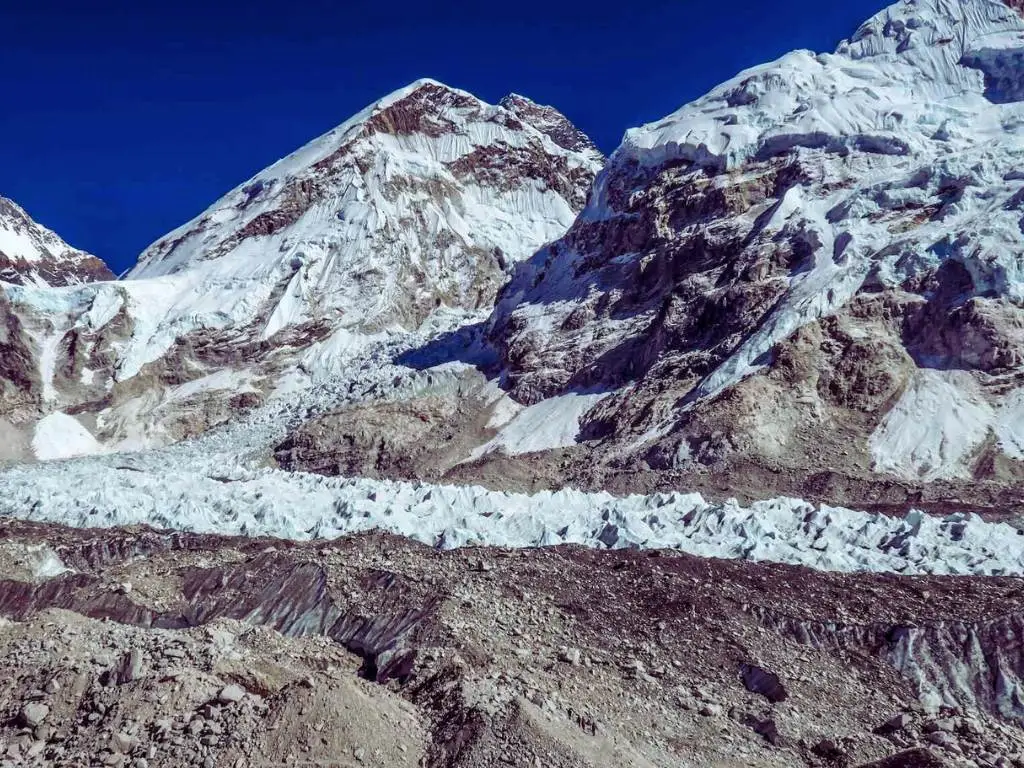
Accommodation and Meals on the Trek
Accommodations in EBC and Gokyo Lakes Trek is quite comfortable. The rooms are comfortable and you get to select the rooms of your choice in lower altitude regions like Lukla, Namche, and Phakding with an option of an attached washroom.
But as you ascend higher, the choices will decline. You have to stay in the twin-sharing rooms during the trek at a higher altitude. But the rooms will be cozy with a blanket to keep you warm enough.
You might have to compromise on the accommodation but the meals you will get on the menu will surprise you. The menu consists of local, Asian, and Western cuisines. The teahouses will serve you standard meals during the trek.
Since you will be trekking at high altitudes, you should drink lots of liquids like green tea, lemon tea, hot lemon, ginger tea, and garlic soup (a must for high altitudes) along with fresh vegetables.
Internet and Communication
You can get wifi services in Lukla, Phakding, and Namche Bazaar (lodges may apply some extra charges here). But as you hike higher, teahouses won’t have wifi services and you may have to get internet service through wifi cards.
Wifi cards are easily available on the teahouses and you have to pay extra charges for the wifi cards depending upon the internet package you buy. It will have an option of 24 hrs internet package to 48 hours. The internet speed is good and smooth enough for normal surfing.
Communication through SIM cards may not be possible in all places. However, in some high-altitude places, communication might work if the weather is clear. But SIM cards are not a reliable option for communication.
Internet might be the only option for you to connect with your home or close ones.
Electricity and Water on the Trek
All the lodges and teahouses on the way to Everest Base Camp and Gokyo Lakes have electricity. On the high-altitude, teahouses have solar-powered electricity. You can recharge your camera and cell phone there. However, you might need to pay extra for this service.
You can buy packed mineral water from local lodges and en-route shops easily. You can also fill your bottle with boiled water at an extra cost.
Make sure to use water purification tablets even if you have filled your water from teahouses.
You should not drink water from rivers, taps, or wells up in trek regions as it might not be drinkable.
Physical Fitness Required on the Trek
The trek to Everest Base Camp and Gokyo Valley is a challenging trek where you often have to hike for 6 - 7 hours a day. It demands good physical fitness from the trekkers.
It is always an advantage if you have prior experience of trekking in Nepal before taking on this trek. If you have a decent physical fitness it will work. You can see trekkers of different sizes, shapes, and ages who have completed the trek. You need to have good stamina and physical endurance as you have to walk many uphills and downhills throughout the trek.
You would better do some physical home workouts or walk for at least 30 minutes a day for a month before going on to the trek. Always walk at your own pace and do not compete with other trekkers on the trek.
Equipment List for Everest Base Camp and Gokyo Lake Trekking
Everest Base Camp with Gokyo Lake Trek is a long and equally challenging Trek in Nepal. Planning a packing list for trekking in Nepal is a must for any trek as the equipment you carry on the trek will determine your comfort and safety on the trek.
For such a long trek, you need to be well-prepared and carry only the essential equipment so you do not burden yourself and carry a heavy backpack. If you are with any trekking companies they will guide you for packing the essential items and equipment list for the trek.
Even if you are hiring a porter don’t overweight your backpack. Carry only the essential equipment for the trek. The list is the same as of packing list for Everest Base Camp Trek. Here is the packing list to help you pack.
Clothes For Head
- Sun hat or scarf.
- Winter hat or insulating hat.
Hands
- Inner Gloves - Thin and lightweight
- Outer gloves - Waterproof and thick
Clothes For Body
- Hiking T-shirts.
- Hiking shorts.
- Fleece pullover hoodie.
- Hooded rain jacket.
- Fleece jacket.
- Trekking pants.
- Sports Underwear.
- Down jacket (available for rent in Kathmandu).
- Sweater.
- Waterproof jacket and pants.
Footwear
- Hiking Boots.
- Sandals or Running Shoes for Teahosue stay.
- Thin Socks (Take an extra pair).
- Thick wool socks (Take an extra pair).
Essential Gear
- Backpack or daypack (size depends on whether you take a porter or not).
- Thermal flask for keeping warm water.
- Reusable water bottle.
- Power bank.
- Water purification tablets. Highly Recommended
- Trekking poles.
- Trash bags.
- Headtorch.
- UV protection sunglasses.
- Crampon.
- Sleeping bag (if you are trekking in the winter season).
Toiletries
- Medium-size drying towel.
- Toilet paper.
- Toothbrush & Toothpaste.
- Shavekit.
- Deodorants or perfumes.
- Bio-degradable soap.
- Nail clippers.
- Small mirror.
Extras and Medical Supplies
- First aid kit.
- Sunscreen with high SPF.
- Lip balm with SPF
- Moisturizing Creams.
- Sanitizer.
- Medicines (Diarrhea, Headache, and Altitude Sickness).
- Cash in Nepali currency.
- Camera (optional).
- Binoculars (optional).
- Blister Plasters
When is the Best Time for EBC and Gokyo Lakes Trek?

The best seasons for the Everest Base Camp Trek and Gokyo Lakes trek are the Autumn season (September- November) and Spring season (March - May). The weather in the Everest Region is unpredictable and you can face snowfall at any time of your trek.
The favorable trekking time for this trek is similar to the best time for Everest Base Camp Trek. However, you need to cross through a high-altitude mountain pass in this trek which can influence your preferred time and season for this trek.
Trekking becomes challenging during winter because of heavy snow and rainfall during the monsoon, but still, some trekkers find this exciting due to fewer crowds throughout the trails.
Autumn Season (September - November)
Autumn season is one of the best seasons to trek to Everest Base Camp and Gokyo Lakes.
A large number of trekkers visit this trek route from September to November. The monsoon gradually ends, and a perfect climate emerges with favorable temperatures for trekking.
During this time, the skies are mostly clear, the mountains shine making a perfect view. You are highly recommended to trek during this time.
Spring Season (March - May)
Another perfect season to trek is the Spring season from March to May. It is right before the rainy season starts in Nepal.
During this time, the days are long, the temperature is quite warm, and the trek is more comfortable. If you wanna see rhododendrons blooming in the trails then this season is for you.
Monsoon Season (June - August)
The rainfall season hits its peak during this time at altitudes below 3500 meters. Due to heavy rainfall and uncertain weather conditions, flights to Luka may get delayed from time to time and get canceled, but trekkers still trek to Everest Base Camp and Gokyo Lakes in these months.
The trekking conditions might get tough due to foggy weather, high temperatures, heavy rain, and landslide risks. The trek is quite challenging but not impossible.
Winter Season(December - February)
During this time, the temperature is lowest in Nepal. Nights get colder during this time but day times are generally clear.
However, trekking should not be difficult and many trekkers trek during this time attracted by the clear skies and lesser crowds. December is quite cold, and the paths are full of snow.
FAQs
Cho La Pass is the highest point in the trek situated at an altitude of 5420 m / 17,783 ft above sea level.
Crossing through the Pass is the toughest route in EBC and Gokyo Lakes Trek. You might need crampons because you will be walking on frozen glaciers while crossing the Pass.
The difficulty level of EBC and Gokyo Lakes Trek is considered a hard trek. It is one of the hardest treks in Nepal.
It is a high-altitude trek and takes relatively longer days to complete. It demands good physical fitness for you to complete this trek.
Make sure to gain some trekking experience and get used to altitude treks in Nepal before going on to this trek.
There are ATMs available only in Lukla and Namche Bazaar. However, you can’t rely completely to get ATM services at such high altitudes
You better carry extra cash with you either from Kathmandu or Manthali.
You will need to work 5 - 7 hours a day throughout the trek route depending upon the destination.
Yes, you can see Everest and other 8,000-meter peaks like Lhotse, Makalu, and Cho Oyu. You can also see other mountains including Pumori and Nuptse.
It will take 16 Days from Kathmandu to complete Everest Base Camp and Gokyo Trek.
You may not have local mobile network connections in most of the places as your mode of communication. However, you will have internet option in the form of Wi-Fi cards with recharge options of 24 hrs and 48 hrs internet package. The internet speed is decent with good and easy connectivity.
Yes, you can charge the electric equipment during the trek but you must pay certain amount for the charging service.
No, you do not need any technical climbing equipment for the trek. However, you will need to carry pair of crampons to cross Cho La Pass.
